Bulbs
Flower Basics
Flower Beds & Specialty Gardens
Flower Garden
Garden Furniture
Garden Gnomes
Garden Seeds
Garden Sheds
Garden Statues
Garden Tools & Supplies
Gardening Basics
Green & Organic
Groundcovers & Vines
Growing Annuals
Growing Basil
Growing Beans
Growing Berries
Growing Blueberries
Growing Cactus
Growing Corn
Growing Cotton
Growing Edibles
Growing Flowers
Growing Garlic
Growing Grapes
Growing Grass
Growing Herbs
Growing Jasmine
Growing Mint
Growing Mushrooms
Orchids
Growing Peanuts
Growing Perennials
Growing Plants
Growing Rosemary
Growing Roses
Growing Strawberries
Growing Sunflowers
Growing Thyme
Growing Tomatoes
Growing Tulips
Growing Vegetables
Herb Basics
Herb Garden
Indoor Growing
Landscaping Basics
Landscaping Patios
Landscaping Plants
Landscaping Shrubs
Landscaping Trees
Landscaping Walks & Pathways
Lawn Basics
Lawn Maintenance
Lawn Mowers
Lawn Ornaments
Lawn Planting
Lawn Tools
Outdoor Growing
Overall Landscape Planning
Pests, Weeds & Problems
Plant Basics
Rock Garden
Rose Garden
Shrubs
Soil
Specialty Gardens
Trees
Vegetable Garden
Yard Maintenance
How to Grow Potatoes in a Barrel of Sawdust
How to Grow Potatoes in a Barrel of Sawdust. You can raise your own potatoes even if you don't have space for a garden. They are very easy to grow in a barrel. If the container is filled with sawdust, harvesting your potatoes at the end of the year will be super easy.

You can raise your own potatoes even if you don't have space for a garden. They are very easy to grow in a barrel. If the container is filled with sawdust, harvesting your potatoes at the end of the year will be super easy.
Things You'll Need
Metal, plastic or wooden container
Clean sawdust
Seed potatoes
Find your barrel. You can use an old metal or plastic trash can, or a wooden barrel. The number of potatoes you can grow will depend on the size of the container. Make a series of holes, about six inches apart in each direction, in the bottom of your barrel. These will provide drainage and help keep the potatoes from rotting because of too much water. Spread a sheet of fiberglass window screening over the holes and add about six inches of soil in the bottom of the barrel. Top that with a four inch layer of clean sawdust.
Get your seed potatoes. Unlike most vegetables, potatoes are not usually grown from seeds. They are sprouted from the eyes of fully grown potatoes. There are commercial vendors of certified seed potatoes and you can probably find them at a local garden store. Some online sources are listed in the Resources section below. Do not use potatoes from the grocery store. Those are usually sprayed with an anti-sprouting chemical. Even if they are starting to sprout, they will not develop properly. Keep some of this years harvest to plant next year and you wont have to buy them again.
Cut the seed potatoes so that each chunk contains two eyes then let the pieces sit for a couple days so the cut surfaces dry out. Next, push the eyes down into the layer of sawdust in the barrel so they are just barely covered. Dampen, don't soak, the sawdust. You should see sprouts poking up through the sawdust in a few days.
When the sprouts are a couple inches high, add more sawdust to cover them up again. Give them a watering and wait a few more days. Repeat this process of covering the new sprouts and watering until the sawdust level is just below the rim of the barrel. Depending on the size of your container, by the time it is full, you will have two or three feet potatoes growing in the barrel. All you will have to do then is water the plants occasional. No weeding necessary.
Harvest your potatoes when the plants stop growing and the leaves turn from green to yellow (around September or October). One of the advantages of growing in a barrel is that there is no need to dig. Just tip your barrel over on it's side, jiggle it a little to loosen the sawdust and everything should slide right out. The used sawdust will make a great mulch for flower beds. Enjoy your tasty homegrown potatoes but don't forget to set a few aside for planting next year.